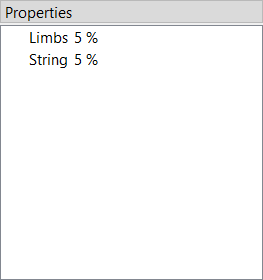Damping
Damping allows to account for energy dissipation, for example due to internal friction/hysteresis of the materials. It only has an effect in dynamic analysis.

Since modelling all the different forms of energy dissipation in a bow in an exact way would be too complex, the damping is reduced to two empirical values: The damping ratio of the Limbs and the damping ratio of the String.
The damping ratio characterizes how quickly oscillations decay over time:
-
An oscillation with a damping ratio of 0% is undamped, it doesn't dissipate any energy and just keeps going with a constant amplitude.
-
The higher the damping ratio the faster the amplitudes decay over time, losing energy with each oscillation.
-
Once the damping ratio reaches 100% there is no longer any oscillation (no overshoot), this is called critical damping.
See also the table below for a visualization of those three cases.
| Damping | Amplitude |
|---|---|
| 0% | |
| 10% | |
| 100% |
Note: The damping ratios of a bow's limbs and string are mostly empirical and there isn't yet much practical experience. Realistic values are probably in the range of 1 - 10% though.
Note: Due to numerical issues, high damping ratios (> 10%) might not work very well right now.
Note: In more technical terms, the limb's damping ratio applies to its first eigenmode in unbraced state and the string's damping ratio applies to its first eigenmode in longitudinal direction.